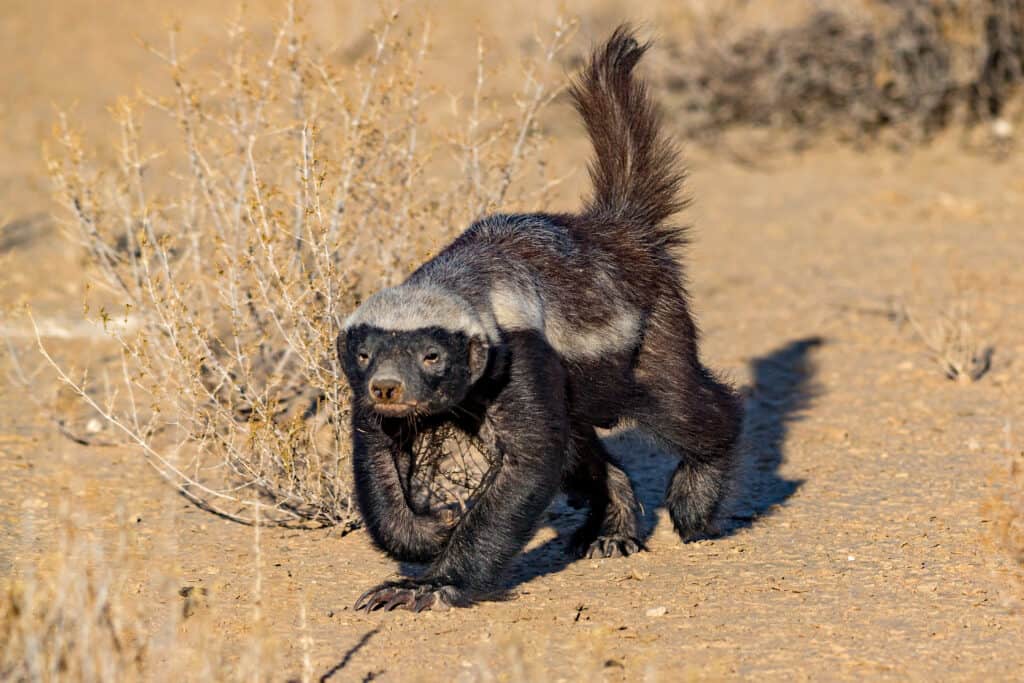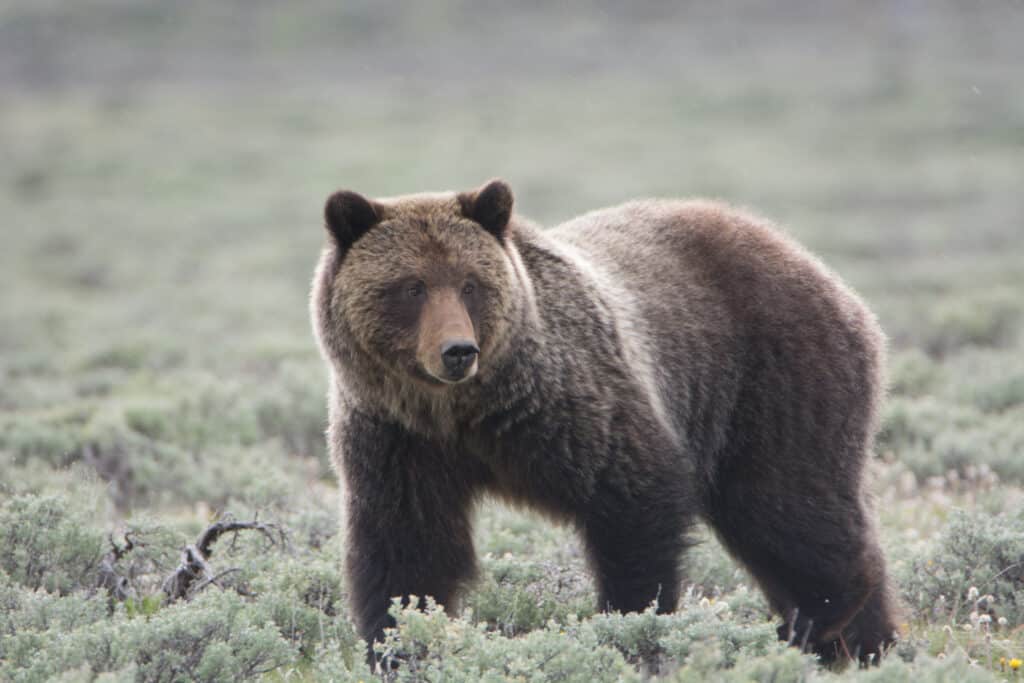Grizzly bears are renowned for being some of the toughest mammals across their extensive range. Meanwhile, honey badgers are known for not giving a hoot about the toughness of other creatures when they challenge them for food or territory. So, what would happen in a matchup between a grizzly bear vs. a pack of honey badgers?
We’ll take a close look at this fight and show you what the most likely outcome would be! Will the tenacity of the honey badgers be enough to overcome the fierce strength of the grizzly bear?
Comparing A Grizzly Bear And A Pack Of Honey Badgers

| Grizzly Bear | Honey Badger | |
|---|---|---|
| Size | Weight: anywhere from 400 to 700 pounds on average, up to 1,200 pounds Length: grow between 7 and 10 feet in length Height: grow between 3 and 3.5 feet tall at the shoulder, with some reaching 4 feet | Weight: from 11 to 35 pounds Length: from 1.5 to 2.5 feet long Height: between 9 and 11 inches |
| Speed | Can hit a max speed of 35 mph while running | up to 19 mph |
| Defenses | – Large, powerful bodies that are hard to bring to the ground and kill – Layers of fur, fat, and skin protect grizzly bears from damage – Can quickly run away from a fight | – Very swift and agile animal – Has thick skin that can help it resist attacks – Can hide in small areas to avoid predators – May unleash a strong musk that can make enemies flee |
| Offensive Capabilities | – Has a powerful bite that reaches 975 PSI – Have 1-inch teeth and 3-inch canine teeth – Can use their big paws to smash and slash prey – Claws reach between 3 and 5 inches long – Prefer to use all manner of attacks to maul prey | – They have sharp 1.5-inch claws – Sharp teeth and a high bite force that helps them dig into the flesh of enemies – Goes for well-aimed bites rather than exsanguinating prey |
| Predatory Behavior | – Mostly scavenge and forage for food – Can hunt prey by using their senses to find animals and chasing them down – Use some elements of ambushing prey, but they usually get close to prey before charging rather than a true ambush | – Daring predators that pursue their prey – May even chase their prey into their burrows |
What Are The Key Differences Between A Grizzly Bear And A Honey Badger?
The most significant differences between a grizzly bear and a honey badger are their size and attack methods. The average grizzly bear weighs up to 700 pounds or more, stands up to 4 feet tall at the shoulder, and grows about 7 feet long on average. Meanwhile, the average honey badger only weighs up to 35 pounds, grows about 2.5 feet long, and stands less than a foot tall.
While honey badgers only have their teeth to attack, grizzly bears use a multi-faceted attack of claws, bites, shaking, and smacks called mauling. These differences will greatly impact the fight, ultimately limiting the honey badgers’ means of attack while giving the grizzly a variety of options when facing these deadly foes.
What Are The Key Factors In A Fight Between A Grizzly Bear Vs A Pack Of Honey Badgers?
The most important factors in a battle between grizzly bears and a pack of honey badgers include the number of combatants, but also the individuals’ size, speed, attack powers, and more. We’ll explore each of these factors and determine what animal has an edge over the other.
Grizzly Bear Vs. Honey Badger: Size

Grizzly bears are larger than honey badgers.
©Scott E Read/Shutterstock.com
A grizzly bear is much larger than a honey badger. As we’ve said, the average grizzly bear can weigh up to 700 pounds on average and over 1,000 pounds at its largest. They stand between 3 and 4 feet tall at the shoulder and grow 7 feet long or more.
Honey badgers are far smaller, only weighing between 11 and 40 pounds, grow up to 2.5 feet long, and stand less than 1 foot tall.
The grizzly bear has a significant advantage in size.
Grizzly Bear Vs. Honey Badger: Speed
Surprisingly, a grizzly bear is faster than a honey badger. The average honey badger can run about 19 mph at their maximum, but grizzly bears can hit speeds of 35 mph while running at their fastest. These creatures can take down large deer after beating them in a foot race.
The bear has a serious speed advantage, so the honey badgers may not be able to escape this fight even if they want to.
Grizzly Bear Vs. Honey Badger: Defenses
The average honey badger has a fair amount of physical protection. Their skin is thick and has some looser portions that allow the honey badger to counterattack if it finds itself being held by another animal. Moreover, they can fit into small spaces and use their musk to make other animals unwilling to eat them.
Grizzly bears are very large and strong. That makes them incredibly hard to kill, especially for animals that are smaller and weaker than them. Grizzly bears have several inches of protection around their bodies, including fur, fat, and skin. Lastly, grizzly bears can successfully run in this scenario.
In short, grizzly bears have a defensive advantage.
Grizzly Bear Vs. Honey Badger: Offensive Capabilities

Honey badgers are aggressive.
©Braam Collins/Shutterstock.com
The honey badger makes up for its somewhat small teeth with a powerful bite force and sheer aggression. This animal likes to bite at the weak spots on its prey to end the fight quickly and without much of a fight.
Grizzly bears have a powerful bite that can reach 975 PSI in strength. They drive 3-inch canines and other 1-inch teeth into their prey, biting weak spots and grasping their prey. They can easily break vertebrae and other bones in their prey. That’s not all they have, though.
Grizzly bears also use their large paws to smack prey along with long claws to gash them, even though the claws aren’t that sharp. Grizzlies like to combine their attacks, mauling prey with a variety of strikes.
All told, the grizzly bear has an advantage in offensive capacities.
Grizzly Bear Vs. Honey Badger: Predatory Behavior
The honey badger is a predator that hunts and pursues its prey, even if they are underground. Grizzly bears are part-time hunters, using opportunism to find and kill their prey. They’ll run down their prey and maul them to death.
Who Would Win In A Fight Between A Grizzly Bear Vs A Pack Of Honey Badgers?

The number of honey badgers is not enough to overcome the size and sheer ferocity of a grizzly bear.
©Jilll Richardson/Shutterstock.com
A grizzly bear would win a fight against a pack of badgers. The number of honey badgers, let’s say five, is not enough to overcome the size and sheer ferocity of a grizzly bear. Given a grizzly bear’s power, the size of its teeth, its large paws, and body weight, the bear only needs to land a single attack to take out a honey badger, especially if it’s a bite to the back or head.
Meanwhile, nothing that a honey badger can do is enough to seriously harm or kill a grizzly bear. The bear is simply too large and strong. A group of honey badgers isn’t going to “go for the eyes” or “bite through the bear’s jugular vein.”
They’re going to try to intimidate the bear, and the bear is going to work its way through the group using vicious mauling attacks. The honey badgers can emit a musk to make the grizzly bear pause its attack, but that won’t be enough to secure a decisive win for the smaller animals.
Even if they try to run, the grizzly is faster, and it could take each of them down individually unless they split up and run in several different directions. All in all, the honey badgers die in this fight.
Other Animals That Could Take Down A Grizzly Bear
While it might seem like the grizzly bear is unstoppable, between its size, speed, and predatory capabilities, there are actually quite a few animals that would be able to take down this tough mammal. Here are just a few:
- The Rhinoceros. The average rhino weighs about 2.5 tons and although it does have a massive horn, it is still able to trample a bear. Although the grizzly is more aggressive, the sheer power and size of the rhino is enough for it to do enough damage to take out the bear.
- The Moose. The tallest animal in North America stands at nearly 7 feet tall and has weights of up to 1500 pounds. It uses its large antlers to defend itself and its territory. Like the bison, it is very muscular and thick, making it hard to take down. The moose can run just as fast as the grizzly, with speeds of up to 35 miles per hour. With its antlers or a kick, the moose could easily injure or kill a bear.
- The Siberian Tiger. This tiger is the strongest and largest of all the great cats, weighing on average 660 pounds and a height of 4 feet. Because of their immense power, tigers have the greatest chance of bringing down a grizzly bear. They know where to bite to bring down their prey.
- The Hippopotamus. A hippo weighs more than 4000 pounds, is around 5 feet tall, and is the third-largest terrestrial animal in the world. They have razor-sharp tusks, used for combat and to scare prey away, and will use them, if needed, to kill. Their powerful bite is enough to split a crocodile in half. The hippo has such thick skin that it most likely wouldn’t be injured by a bear’s claws.
- The Elephant. The African elephant is the largest land mammal. With an average height of 10.5 feet and an average weight of 6.6 tons, there isn’t much they would have to do to take down a bear. With simply a swipe of their trunks, they can take out the grizzly. When you then add in their massive tusks and thick skin, its unlikely that the bear would have any chance.
The photo featured at the top of this post is © Perpis/Shutterstock.com
Thank you for reading! Have some feedback for us? Contact the AZ Animals editorial team.






